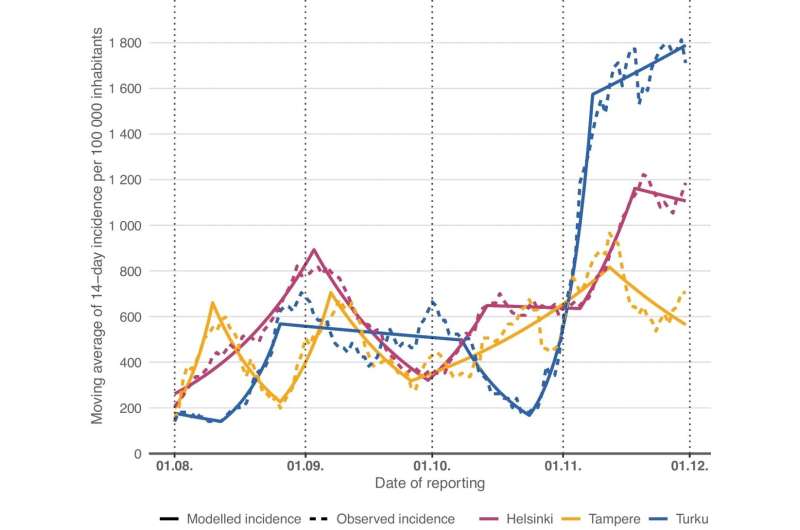May 2, 2023 report
This article has been reviewed according to Science X's editorial process and policies. Editors have highlighted the following attributes while ensuring the content's credibility:
fact-checked
peer-reviewed publication
trusted source
proofread
Finnish study finds additional citywide recommendations did little to curb COVID-19 cases

A report from the Finnish Institute for Health and Welfare, Finland, published in BMC Public Health, looked into the effectiveness of a city-based mask-wearing policy among 10 to 12-year-olds during the fall of 2021. In the paper "Face mask recommendations in schools did not impact COVID-19 incidence among 10 to 12-year-olds in Finland—joinpoint regression analysis," the researchers found that more cautious city masking recommendations of school children ages 10 to 12 were ineffective in reducing the incidence of COVID-19 in the general population.
In the fall of 2021, a nationwide recommendation was to use face masks in schools for pupils ages 12 years and above in Finland. Some cities recommended face masks for younger pupils as young as 10. A younger (7 to 9) population was not covered by any masking recommendation.
The team compared the incidences of COVID-19 in 14-day periods over four months among individuals aged 7 to 9, 10 to 12, and 30 to 49 years. COVID-19 case numbers were obtained from the National Infectious Disease Registry (NIDR) of the Finnish Institute for Health and Welfare, where clinical microbiology laboratories report all positive SARS-CoV-2 tests, including information such as date of birth, gender, and place of residence, enabling the calculation of incidences in the study.
The comparison of trends of 14-day incidences between Helsinki and Turku among 10 to 12-year-olds, and for comparison, also among ages 7–9 and 30–49 found no additional effect gained between the age groups of the unvaccinated children (10–12 years versus 7–9 years) and mask-wearing at school.
The study could not account for how rigorously 10 to 12-year-olds used their masks at school, what kind of masks might be used or even compliance with the city recommendation compared to the less strict national recommendations. The authors point out that this study was conducted during the delta variant and may not be valid for comparison to omicron or other variants.
While city recommendations of younger mask-wearing did not result in greater reductions in cases, the researchers conclude that this may indicate that COVID-19 cases in schools merely reflect community infections rather than school outbreaks.
More information: Aapo Juutinen et al, Face mask recommendations in schools did not impact COVID-19 incidence among 10–12-year-olds in Finland—joinpoint regression analysis, BMC Public Health (2023). DOI: 10.1186/s12889-023-15624-9
© 2023 Science X Network




















